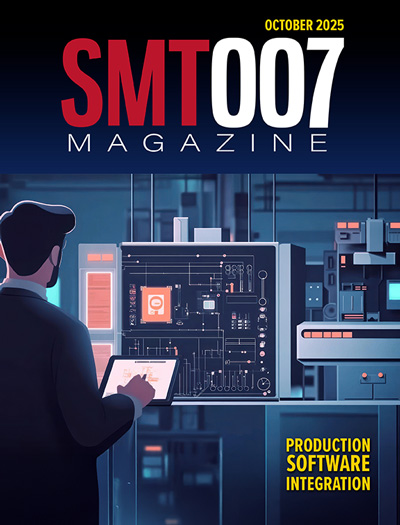-

- News
- Books
Featured Books
- smt007 Magazine
Latest Issues
Current Issue
Production Software Integration
EMS companies need advanced software systems to thrive and compete. But these systems require significant effort to integrate and deploy. What is the reality, and how can we make it easier for everyone?

Spotlight on India
We invite you on a virtual tour of India’s thriving ecosystem, guided by the Global Electronics Association’s India office staff, who share their insights into the region’s growth and opportunities.

Supply Chain Strategies
A successful brand is built on strong customer relationships—anchored by a well-orchestrated supply chain at its core. This month, we look at how managing your supply chain directly influences customer perception.
- Articles
- Columns
- Links
- Media kit
||| MENU - smt007 Magazine
Selecting X-Ray Inspection Equipment
January 24, 2018 | Russell Poppe, JJS ManufacturingEstimated reading time: 6 minutes
The D, of course, stands for dimensions. There are three kinds of systems:
• 2D, which provides a straight top-down view
• 2.5D, which allows top down and tilted or angled views
• 3D, which is a three-dimensional re-construction of the assembly. This might use such techniques as tomography, laminography or (for the full 3D effect) computed tomography, or CT.
Figure 2: In this example, voids in the solder are highlighted in green.
Of course, the more you get to see, the slower the inspection is. Complex CT scans for example can take hours to make. If the aim is to look at missing solder balls under a BGA for example, or shorts between them, then 2D can be fine. However, tilting can help get a better view if there are components obscuring the area of interest. 3D might be used for detailed quality investigations.
3. Ease of use
Some systems allow a degree of automated inspection, for example by programming sequences of inspections with pass/fail criteria. This of course makes repeatable inspection and operation very easy, and allows an in-line process if required. Setting it up though, or performing ad-hoc inspections, does require some skill.
While modern X-ray systems are easy to use, the inspector does need to understand what all the settings do (e.g., the voltage and contrast settings we mentioned before) and be able to interpret what they are seeing, which does require a reasonable knowledge of PCB assembly. There can be features that make image interpretation a bit easier, for example, by applying color.
4. Maintenance
It is worth remembering that the Health & Safety Executive (HSE) must be notified before using X-ray equipment. Obligations may also exist around creating rules or procedures for use, and engaging radiation protection supervisors and advisors. The equipment supplier should be able to provide advice, and it is a good idea to have them perform an (at least) annual health check on the system. It is also worth mentioning that there are different types of X-ray tube. ‘Open tube’ types are relatively quick and inexpensive to replace—perhaps a few pounds and a couple of hours—but need doing so after every 200-300 hours or so of use. ‘Closed tube’ types can last for many years but are much more expensive, maybe thousands of pounds. So perhaps the best choice depends on how much you will use the system.
The X-ray detectors tend to be standard or high-definition flat panels. The X-rays will cause these to degrade over time, typically around 20% after 10 years. While still usable, replacement after eight to 12 years could be advisable.
It is also worth finding out the common failure modes on systems, as while the component parts are similar, they can be assembled in different ways. For example, power supplies, connectors or cables can need replacing in time. Hopefully, this article has helped you understand some of the areas to focus on when looking to invest in X-ray inspection equipment.
Page 2 of 2Testimonial
"Our marketing partnership with I-Connect007 is already delivering. Just a day after our press release went live, we received a direct inquiry about our updated products!"
Rachael Temple - AlltematedSuggested Items
Indium Experts to Deliver Technical Presentations at SMTA International
10/14/2025 | Indium CorporationAs one of the leading materials providers to the power electronics assembly industry, Indium Corporation experts will share their technical insight on a wide range of innovative solder solutions at SMTA International (SMTAI), to be held October 19-23 in Rosemont, Illinois.
Knocking Down the Bone Pile: Revamp Your Components with BGA Reballing
10/14/2025 | Nash Bell -- Column: Knocking Down the Bone PileBall grid array (BGA) components evolved from pin grid array (PGA) devices, carrying over many of the same electrical benefits while introducing a more compact and efficient interconnect format. Instead of discrete leads, BGAs rely on solder balls on the underside of the package to connect to the PCB. In some advanced designs, solder balls are on both the PCB and the BGA package. In stacked configurations, such as package-on-package (PoP), these solder balls also interconnect multiple packages, enabling higher functionality in a smaller footprint.
Indium to Showcase High-Reliability Solder and Flux-Cored Wire Solutions at SMTA International
10/09/2025 | Indium CorporationAs one of the leading materials providers in the electronics industry, Indium Corporation® will feature its innovative, high-reliability solder and flux-cored wire products at SMTA International (SMTAI), to be held October 19-23 in Rosemont, Illinois.
‘Create your Connections’ – Rehm at productronica 2025 in Munich
10/08/2025 | Rehm Thermal SystemsThe electronics industry is undergoing dynamic transformation: smart production lines, sustainability, artificial intelligence, and sensor technologies dominate current discussions.
Amplifying Innovation: New Podcast Series Spotlights Electronics Industry Leaders
10/08/2025 | I-Connect007In the debut episode, “Building Reliability: KOKI’s Approach to Solder Joint Challenges,” host Marcy LaRont speaks with Shantanu Joshi, Head of Customer Solutions and Operational Excellence at KOKI Solder America. They explore how advanced materials, such as crack-free fluxes and zero-flux-residue solder pastes, are addressing issues like voiding, heat dissipation, and solder joint reliability in demanding applications, where failure can result in costly repairs or even catastrophic loss.


